
Jean de Bloch, The War of the Future (1899) [extracts]
[Created: 19 July, 2014]
[Updated: 17 January, 2017] |
Source
Jean de Bloch, The Future of War in its Technical, Economics, and Political Relations. Translated by R.C. Long, and with a Conversations with the Author by W.T. Stead, and an Introduction by Edwin D. Mead (Boston: Published for the International Union, Ginn and Company, 1903). [PDF 8MB].
Contents
- Introduction, by Edwin D. Mead.
- Conversations with the Author, by W. T. Stead
- Author's Preface
- PART I MILITARY AND NAVAL DEVELOPMENTS
- I. How War will be Waged on Land
- II. Plans of Campaign : Possible and Impossible
- III. The Future of Naval Warfare
- IV. Does Russia Need a Navy?
- V. What Wars have Cost in the Nineteenth Century
- VI. What they will Cost in the Future .
- VII. The Care of the Wounded
- PART II ECONOMIC DIFFICULTIES IN TIME OF WAR
- I. In Russia
- II. In Britain
- III. In Germany
- IV. In France
- V. Effect of War on the Vital Needs of Peoples
- VI. Probable Losses in Future Wars
- VII. Militarism and its Nemesis
CHAPTER VI. PROBABLE LOSSES IN FUTURE WARS
[319]
L— Statistics for Estimating Losses.
Cold Steel. —The use of the bayonet, the lance, and the sword have not changed. As we have shown in detail in another place the proportion of casualties caused by cold steel is insignificant.
Small Arms. —Since the last great wars the power of arms has grown immensely and every day witnesses fresh improvements.
Let us quote some facts as example. In Germany, Austria, France, Russia, England, and Turkey a rifle with a calibre of froII^ 7.62 to 8 mil. is employed. The distinctive feature of these weapons is the force of the blow, depending from greater initial speed and rotation of the bullet. This initial speed varies from 680 to 700 yards a second, and the number of revolutions from 2475 to 2640 a second. In the Italian, Dutch and Roumanian armies rifles have been adopted with a calibre of 6.5 mil., with an initial speed of 750 yards, and rotation 3830 a second. In the United States a 6-mil. rifle has been adopted. In Germany and Austria experiments with a S.omil. rifle gave remarkable results. The significance of these changes may be understood from the fact that the jjenetrative force of the 6.5-mil. rifle is 44 per cent, greater than that of the 8-mil. rifle.
The effect of a rifle shot depends first of all upon the energy preserved by the bullet on reaching its target and then upon the weight of the bullet in relation to its diameter [320] and upon the speed of its flight. The following diagram illustrates the difference in power of the rifles of 1877 and 1890.
Amount in Metro-Kilogrammes of Living Force of a Bullet on each Quadratic Centimttre of its Transverse Area on Striking Obstacles at various Ranges.
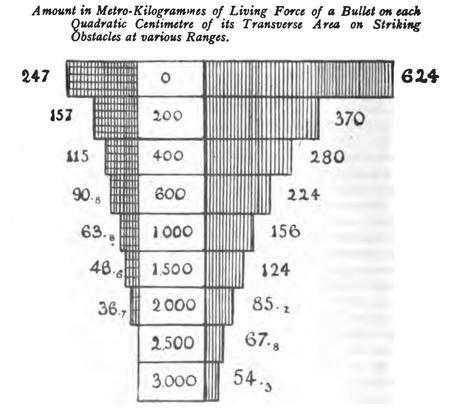
As concerns the 5-mil. bullets their striking force very considerably exceeds that of the 7,66-mil. bullet.
What will be the effect of such projectiles when employed in war by soldiers equal in equipment and training it is difficult to foretell precisely. Nevertheless such experiments and investigations as have been made help us to form a very vivid picture of the future battlefield.
Experiments in the use of the 5-mil. Mauser rifle [321] against the carcases of horses gave the following results. From a distance of 27, 220, 550, 1100, and 1870 yards, the bullets penetrated 5, 4, 3, 2, and 1 carcases of horses, in each case preserving sufficient energy to penetrate to some extent the following carcase.
Number of Horses' Carcases Penetrated by the Bullets of the Mauser 5 Mil. Rifle at various Ranges.
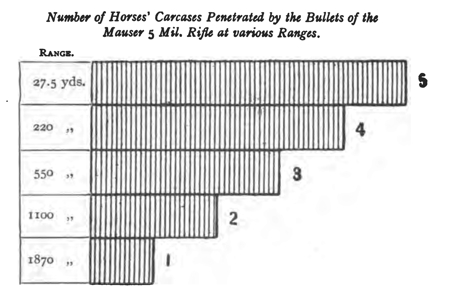
The enormous energy of such projectiles will for another reason cause an increase in the losses of war. Modem covered bullets are effective even in piercing metal. When the old round leaden bullets were used, a tree three inches thick or an earthwork twenty inches thick was an effective protection for soldiers. The modem small-calibre bullet will penetrate earth to the thickness of 78J inches, pierce through a tree and strike those who shelter behind it. In olden times the second rank considered itself protected from danger by the first, the coward took refuge behind a companion. The modem bullet may not only penetrate soldiers in the first two, but even in the third rank.
From this we sec that the number of victims of the modem bullet may be five times greater than that of the old.
[322]
In considering the degree of danger in battle the number of revolutions of a bullet has great importance. The following diagram shows the weight and rotation of bullets in use at various times.
Rotation and Weight of Billets of Various Rifles.
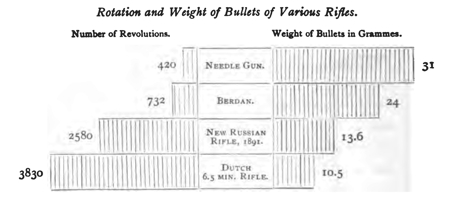
This question has much importance, for upon striking something hard, such as the branch of a tree or a thick bone, the bullet takes an irregular position, and as its revolution continues it causes very serious wounds. It is for this reason that the intervention of a tree or a brick if it be insufficient to stop the bullet only makes it more dangerous. In Nirschau, in crushing the disturbances among the miners, but ten shots were fired, yet seven persons were killed and twenty-five wounded from a distance of from thirty to eighty paces. Many others slightly wounded concealed their injuries so as to escape legal prosecution. Each bullet struck from three to four men. This is explained by the thickness of the mob and the shortness of range. Of the wounded men six died, so that the percentage of death from wounds was 24 per cent., while in the war of 1870 it was only 12 per cent. The general mortality among those struck by bullets was 40.6 per cent.
It cannot be doubted that the immense increase in the penetrative force of bullets, and the gravity of the injuries inflicted, will be one of the most striking characteristics of [323] a future war. The effect of the deformation of bullets on striking hard substances will also be considerable, but concerning this we have no statistics.
The first quality of a rifle is accuracy of fire. In this respect modern weapons possess qualities which ensure a number of casualties incomparably greater than in the past. The bullet of the 6-mil. Mannlicher rifle for a distance of 750 yards will fly so close to the ground that it will strike everything in the line of fire for that distance. With the rifles employed in the war of 1870, the effective distance in a range of 650 yards was 30 yards for the Dreuze and 35 yards for the chassepot. In other words the field of death has grown twenty times. At a greater range than 750 yards the bullets of 1870 almost always struck soldiers on the point of fall; at the present time the Mannlicher bullet aimed at a target 960 yards away, flies so low that it would strike a man for no yards of its flight. Even at a range of 1300 yards it would be effective for 62 yards. The following diagrams show this difference more plainly.
Zone of Effective Fire against Infantry (1 m. 70 c., in height) at various Ranges.
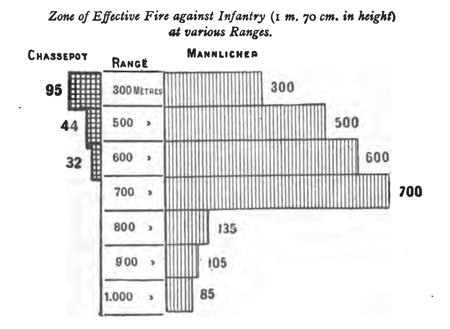
[324]
Breadth of Zone of Effective Fire against Cavalry (2 m. 70 cm. in height) at various Ranges
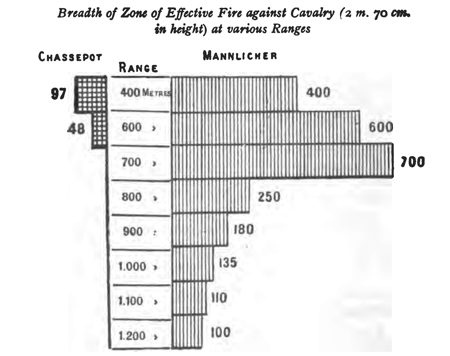
In all armies firing drill has been brought to perfection. The quantity of cartridges expended in training is incomparably greater than before, and the most ingenious methods have been devised for showing inaccuracy of fire or nervousness.
It is easy to see how these circumstances will influence future losses. At the present time the success of aim depends only upon the proper holding of the rifle. Raising the small-calibre rifle to the shoulder and firing mechanically and horizontally, at the present day the rifleman covers a space of 650 to 750 yards. Where in 1870 a special order was needed and attention had to be paid to its execution, the mere mechanical use of the weapon is now necessary. For this reason, too, the range of useful fire, which will not involve waste of cartridges, has immensely increased, as the following diagram shows:
[325]
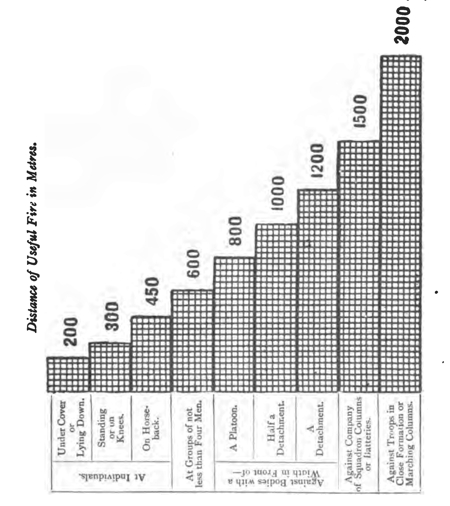
The effect of improved training may be shown by the following figures. In Russia up to 1874, at 650 yards range the accuracy of fire of a battalion was 25 per cent; to-day, with improved training, it is as high as 69 per cent., or almost three times better. The modern rifle so nearly approaches perfection that a well-trained marksman almost certainly hits his mark. In the French and German armies the percentages of successful fire against an infantryman are shown by the following diagrams:
[326]
Percentage of Hits in Fire at One Infantryman.
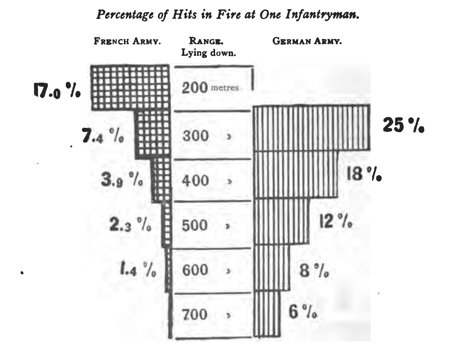
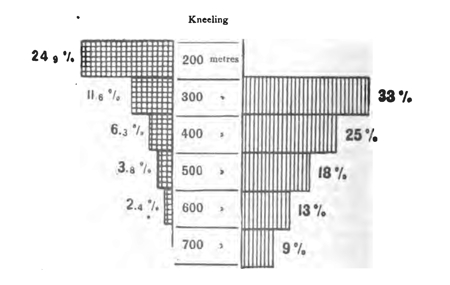
[327]
Percentage of Hits in Fire at One Infantryman.
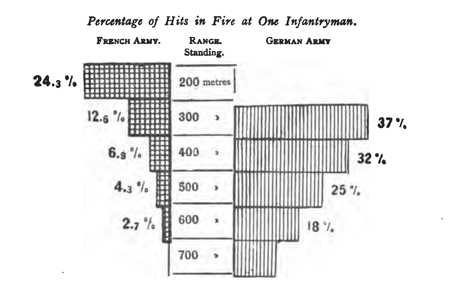
Besides these improvements in weapons all tending to the increase of casualties, the systems of measuring distances have been improved at the same rate. The improved instrument of Colonel Paskevitch adopted by the Russian army ten years ago measures up to 7000 yards in three minutes, while it weighs less than 72.6 lbs. The accuracy of this instrument may be seen from the following diagram:
Deviation of the Paskevitch Instrument in Metres.
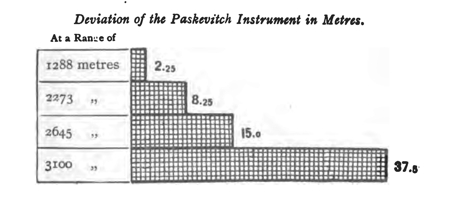
[328]
In later years even more accurate instruments have been constructed.
The increase in the number of cartridges, already mentioned in another connection, carried by soldiers is another factor increasing losses. With the Berdan rifle a Russian infantryman carried 84 cartridges, with the new weapons 150 cartridges; with the 5-mil. rifle the number carried will reach 270.
Number of Cariridges carried by one Soldier with Different Rifles.
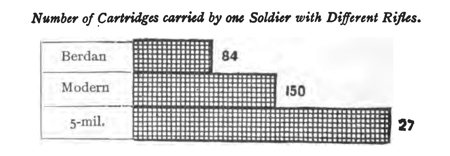
With an even smaller calibre the number of cartridges carried will be from 380 to 575. If we assume that, without having recourse to the reserve, the number of cartridges now carried will be expended, it is easy to see how losses will be increased. The smokelessness of powder is another factor in increasing losses. But to this we have already referred more than once.
On the above statistics we have constructed the following table showing how the old loss of 18 per cent, from rifle fire will be increased, in all cases the lowest conceivable increase having been taken :

From which it appears that the general loss from rifle-fire [329] will grow to 63 per cent. That this estimate is not exaggerated is shown by the Chilian war. Yet, as already stated in the beginning of this work, Professor Gebler gives even a higher value to the effectiveness of the new weapons:

In comparison with this our calculations appear very moderate.
Artillery. —Of the effect of artillery fire the past can give little idea. Such authoritative writers as General Wille, Professor Pototski, and Captain Moch declare that the quick-firing guns now built in France, Germany, and Russia are at least twice as effective as the 1891 type, of which Langlois said : '' We have before us a whole series of improvements of the utmost importance, and must admit that war material has become entirely different from that employed in past wars." In addition to this the quantity of artillery has increased immensely.
In the present day as many projectiles can be fired in the course of a few minutes as were before fired during a whole battle, the best guns giving in the course of three minutes 83 shots and the worst 65. The accuracy of fire is no less remarkable. From a distance of 2000 yards guns have sent four projectiles into the same hole.
A comparison of the effect of 1000 rifle bullets fired by infantrymen attacking in open order with the effect of shrapnel showed that one round of shrapnel is effective over a space twice as long as, and not less wide than, the rifle fire. Experiments show that the fragments of these shells are thrown over a space 860 yards long and 420 wide.
On the basis of comparisons made by Langlois, it appears that the French gun of 1891 is twenty times more effective than that of 1870. In the same period the number of guns has increased from 780 to 4512. From [330] which it appears that the French artillery of 1891 was 116 times more powerful than that of 1871. When the new quick-firing guns now being prepared—which in the opinion of specialists will be twice as effective as those of 1891—are completed, the French artillery will be approximately 232 times more effective than that employed against the Germans in 1870. It may be assumed that the losses will be correspondingly greater. The quantity of ammunition carried will be twice as great as was carried with the former arms. On the estimates of Langlois, in a future battle lasting only two days, every gun will require no less than 267 rounds of ammunition, while if the battle extend over three to four days 500 rounds will be required. With the 136-140 rounds per gun in the armies of the Triple and Dual Alliances, according to the calculations of General Mailer, more than 11,000,000 men might be killed and wounded. With 267 rounds per gun 22,000,000 might be killed and wounded, and with 500 rounds 41,000,000. In consequence, it appears that artillery fire alone might exterminate eight times the number of the armies which could be placed on the battlefield. These figures seem absurd. Nevertheless, they are based on the detailed calculations of Langlois.
In the war of 1870 the losses from artillery fire amounted to 9 per cent, of the armies engaged. What they will be in a future war it is impossible even to guess. The quantity of artillery has increased, each gun being twenty times, and, since the introduction of the latest types, forty times more powerful than those of 1870. Even leaving the increase in the number of guns out of account, the losses of 9 per cent, would be replaced by losses of 180 per cent., though these new guns must in a short time give way to others more perfect. If we base our estimates on these new guns the results would be absurd, not through irregularity of reasoning, but simply because they would show that instruments had been prepared capable of destroying armies many times more numerous than could be placed in the field.
[331]
II.— Influence of Modern Tactics in increasing Losses.
In consequence of the use of long-range weapons and smokeless powder armies will be obliged to surround themselves, for a considerable distance, with commands of sharpshooters so as to render reconnaissance by the enemy difficult. The discovery and destruction of such commands will be a task of no small difficulty. In 1870 for the protection of the German rear 145,712 men with 5945 horses and 80 guns were employed. And since the strength of the infantry then operating was something over 455,000, it will be seen that a sixth part of the whole army had to be set aside to protect communications. Nevertheless the French sharpshooters more than once succeeded in cutting the German communications and causing confusion. If we bear in mind that these franc tireurs were exclusively on foot and had no military training, it will be understood what vast forces would have been required to guard communications from regular chasseur commands and cavalry.
In the present time, in all countries, an attempt is made to give some military training to all men who might be required for service in time of war. Such a state of affairs as resulted in France in 1870, when Paris was actually besieged, and yet hundreds of thousands of men liable to service continued to attend to their civil occupations, will not again be seen. At the very outbreak of war practically all the population liable to service will be either summoned to the operating army, or appointed to serve in the second and third strategical lines.
After this of course there will remain in the country a sufficient number of grown men for such work as the obtaining of information as to the enemy, and the burning of bridges and stores, &c. But generally it must be admitted that even partisan operations will be carried on by organised bodies, and systematically. A result of this will be that even a little war in the future will take a serious form.
[332]
During the manoeuvres of the German army in Alsace-Lorraine attempts were made at transporting infantry in carriages for the purpose of doubling or even trebling rapidity of movement. Two experiments were made. The infantry either covered in one day a great distance, namely, 49I miles with halts for food and change of horses, or made two marches a day, one on foot and the other in carriages.
Military operations will begin in the form of a little war, considerable masses of cavalry being constantly maintained on frontiers, which will be immediately crossed, upon which reconnoitring detachments from both sides will come into contact with one another. It will be most important for such detachments to have light infantry with them in carriages. Of course their movements will be characterised less by regularity than by speed. But the command will be given to picked, experienced officers, and as a result such bodies will be much more dangerous than the French franc tireurs of 1870. At the present day a marksman from a distance of not more than Zoo paces may pick off men at will, and as smoke will no longer betray his position his fire may be very deadly.
The losses suffered in attacks on fortified positions will constantly grow, side by side with improvements in arms. The attackers must advance in loose formation, taking advantage of inequalities in the ground, and of the light earthworks which they will throw up with the aid of trenching instruments. In the war of 1877 the Russian soldiers were imperfectly equipped, and ill-instructed in the making of such works. Yet, in spite of this, earthworks fully proved their value. It was such earthworks which prevented the Turks from driving the Russian army from the Shipka, notwithstanding the immense sacrifices they made. On the other hand picked Russian troops, with a numerical superiority of 25 per cent, and desperate bravery, for a long time failed to take the redoubt of Gorni Dubnyak although they got within a hundred paces of it. In the majority of unsuccessful attacks on Plevna the [333] Russian troops, after great loss, succeeded in getting within bayonet distance of the enemy; cases of nearer approach were very few.
Relying on the confidence with which the smokelessness and long range of his rifle inspire the soldier, commanders will stubbornly hold out in defensive positions, selecting natural cover and supplementing it with artificial defences. That earthworks will be had recourse to very often in the field is shown by the fact, that trenching instruments enter into the equipment of a certain proportion of all infantry. As further evidence, we might point to the instructions delivered to the Guards Corps in 1892 recommending defending bodies always to entrench themselves unless special orders be given to the contrary. It is interesting to see the degrees of equipment of European armies for such work.
Number of Sappers to 100 Infantrymen.
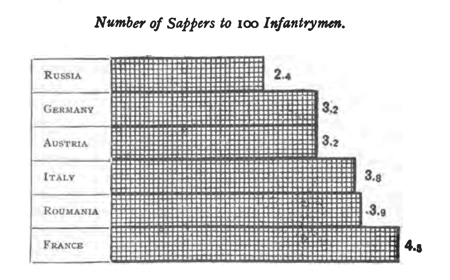
The Belgian authority General Brialmont considers that even the last proportion is insufficient. He declares that six sappers should go to every hundred infantry men. General Killichen goes even farther and would have a sapper for every thirteen infantrymen.
In former times every irregularity in the ground was [334] considered an obstacle in military operations. At the present day knowledge of how to take advantage of these irregularities is a great factor of success. This view has become so generally accepted within the last twenty-five years that all governments have undertaken the examination and measuring of all fields where a future battle might take place. This circumstance is very important. If a Plevna could spring up suddenly upon an unexamined and unprepared spot, what will be the case in a future war when every inch of frontier territory has been prepared for defence ?
In the opinion of the most competent authorities the war of the future will result primarily in a series of battles for the possession of fortified positions. In addition to field works, the attacking troops will have to overcome auxiliary obstacles of every kind near the regular fortifications, that is, at the place where they will run the greatest risk from the defenders* fire. Such obstacles will be constructed of beams, wire nets, and pitfalls. Their de truc-tion will require immense sacrifices. The efiiect of artillery upon such defences is insignificant. Wire nets can only be destroyed by taking them to pieces by men acquainted with the methods of construction. But for this much time will be required. Meantime the foremost of the attackers will be under strong fire from the defence, and may very easily fall under the fire of their own artillery which will be supporting the attack.
Rifle fire over the heads of advancing troops will be practised more often than before, and may prove the cause of great losses. " Observe," says General Skugarevski, " the results of firing in peace time. The targets stand at some hundreds of paces away, yet bullets sometimes furrow the ground at a few decades of paces from the marksman. And this in time of peace. What will happen in war ? " Still more dangerous will prove artillery fire over the heads of troops, since want of coolness, a difikult locality, the distance of the enemy and other unfavourable circumstances may cause inaccurate fire from which advanced troops might suffer severely.
[335]
The amount of losses will depend more or less upon the skill or otherwise with which men are led. Yet even in peace times a deficiency of fully trained officers is felt. It must not be forgotten that a considerable number of the higher officers in modem armies have never been under fire. With the present composition, operating armies can never be properly officered, since the formation of new armies will so exhaust the reserve of officers of the line that a battalion at the front will have no more than eight out of thirty. Thus for every one of such officers there will be three from the reserve who will be inferior in knowledge, in discretion, and in applicability to conditions. Unskilful tactics will immediately react unfavourably on the amount of the losses. The deficiency in fully trained officers will be all the more felt as they will lose heavily in the very beginning of the campaign. The experience of the last wars, although smokeless powder was not used| and the rule that officers were to be first picked of! was not generally accepted, shows how quickly the number of officers on the field of battle will diminish. As a guide in this respect the Chilian war may again be taken. Figures referring to two battles only show that while the number of men killed and wounded was 13 per cent, and 60 per cent, respectively, the number of officers killed and wounded was 23 per cent, and 75 per cent. But if officers are not there to give the example, men will not attack. Prince Hohenlohe, in his "Letters on Artillery," relates the following incident which occurred in the vicinity of Paris : "After driving the enemy from a village its graveyard was occupied by half a company from one of our best regiments. Quite unexpectedly the enemy made a new attack and regained possession of the graveyard, which we were obliged to capture anew. On this being done, I asked the men of the half-company how they could have given up the graveyard to the enemy. The soldiers answered naively: 'But all our officers were killed, there was no one to tell us what to do, so we also went off.'"
The German army in the war of 1877 lost considerably in officers, as will be seen from the following diagram:
[336]
Losses in the German Army in the War of 1870.
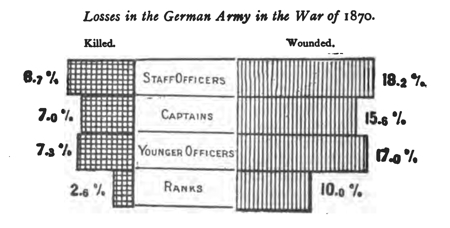
That is to say, the ofEcers sustained twice as many in killed and three times as many in wounded as the lower ranks.
In consequence of improved means of destruction every meeting with an enemy will take a more threatening form than before, and every mistake, every delay, will have more serious consequences. The conditions of war have become enormously more complex. Yet for every hundred soldiers serving with the colours there will be taken from the reserves:

The majority of these reserves will have forgotten what they Icamt in time of service. Of the officers also only a small proportion will be in a high state of efficiency. It would seem that with such conditions field instructions should be elaborated in times of peace, giving precise information as to tactical measures in every contingency. But, as we have already mentioned in another place, in this respect the different armies show deficiencies of various kinds. So far has the confusion gone that in the French [337] army the expression is used " ordre, contre-ordre, dés-ordre." And this is very natural when we bear in mind the want of experience of the new conditions.
Some writers express the opinion that it is a mistake to issue general instructions regulating tactics in a future war, as under certain circumstances their literal interpretation has the most disastrous consequences. In former times when fire was incomparably slower and weaker, and escape from the zone of fire could be effected quickly, the losses from mistakes in tactics were insignificant. But such are the conditions now that a mistake may lead to the extermination of a whole body of troops within a few minutes. The danger has grown immensely, while the factors of safety have diminished. Smoke will no longer betray the position of an enemy's troops, reconnaissance in the face of long-range rifles will be difficult, and the attacking troops will attempt to approach the defenders to within a short distance, at which the ballistic forces of projectiles can no longer receive development, from this distance the deciding weapon, as in former battles, being the bayonet.
But what will be the losses sustained by attacking troops before they get within such a distance ? The advance, of course, will be carried out cautiously and in loose formation. Such an advance against an enemy occupying a strong position and firing over measured distances will be extremely difficult and may even require a two-days' labour.
It is not strange then that certain authors declare that battles will continue three, four, and even fifteen days. Other specialists find that we are returning to the epoch of sieges. Belgrade, Mantua, and Plevna may be repeated. It is very likely that the attacking army, finding decisive victory impossible, will attempt to lock up the enemy on the spot, entrenching itself and making raids for the stoppage of his supplies until the besiegers are starved out.
As we have already explained, the quick and final decision of future battles is improbable. The latest [338] improvements in small arms and artillery, and the teaching of troops to take advantage of localities, has increased the strength of defence. The modern rifle has immense power, and its use is simple and convenient It will be extremely difScult to overcome the resistance of infantry in sheltered positions. Driven from one position it will quickly find natural obstacles—hillocks, pits, and groups of trees—which may serve as points for fresh opposition. The zone of deadly fire is much wider than before, and battles will be more stubborn and prolonged. Of such a sudden sweeping away of an enemy in the course of a few minutes as took place at Rossbach it is absurd even to think. The power of opposition of every military unit has increased so greatly that a division may now accept battle with a whole army corps, if only it be persuaded that reinforcements are hastening to the spot. The case already cited, of the manoeuvres in Eastern Prussia, when a single division sustained an attack from a whole army corps until reinforced, is sufficient evidence of this. The scattering of immense masses over a considerable space means that a successful attack on one point by means of the concentration of superior forces may remain local, not resulting in any general attack on the chief forces of the defence.
In former times either of the combatants quickly acknowledged that the advantage lay with the other side, and therefore refused to continue the battle. The result and the trophy of victory was the possession of the battlefield. The majority of military writers consider the attainment of such a result very questionable.
From the opinions of many military writers the conclusion is inevitable that with the increase of range and fire, and in view of the difficulties with which assault is surrounded, a decisive victory in the event of numerical equality is possible only on the failure of ammunition on one side. But in view of the number of cartridges which soldiers now carry, and the immense reserves in the ammunition carts, it seems more likely, that before all cartridges have been expended, the losses will have been [339] so great as to make a continuation of battle impossible. To the argument that night will interrupt the battle we find an answer in the fact that, thanks to the adoption of electric illuminations, the struggle will often continue or be renewed at night.
In all armies attempts are made to inspire the soldiers with the conviction that a determined assault is enough to make an enemy retreat. Thus, in the French field instructions we find it declared that " courageous and resolutely led infantry may assault, under the very strongest fire, even well-defended earthworks and capture them." But the above considerations are enough to show the difficulty of such an undertaking.
Supposing even that the defenders begin a retreat. The moment the attacking army closes its ranks for assault partisan operations on the side of the defenders will begin. Indeed, it may be said that the present rifle, firing smokeless powder, is primarily a partisan weapon, since armed with it even a small body of troops in a sheltered position may inflict immense losses from a great distance. As the attackers approach, the thin flexible first line of the defence will retreat. It will annoy the enemy with its fire, forcing him to extend his formation, and then renew the manoeuvre at other points.
While the first line of the defenders will thus impede the assault, the main body will have opportunity to form anew and act according to circumstances. The attacking army, though convinced of victory, finding that it cannot get into touch with the rear-guard of the enemy, which alternately vanishes and reappears, now on its flanks, now in front, will lose confidence, while the defenders will take heart again.
It is obvious that, with the old powder, the smoke of which betrayed the fighting front of the enemy and even approximately indicated its strength, such manoeuvres were too dangerous to carry out. It would be a mistake to think that for the carrying on of such operations picked troops are required. The ordinary trained soldier is quite capable. Every soldier knows that two [340] or three brigades cannot entirely stop the advance of an army. But seeing that the attackers may be so impeded that they will gain no more than four or five miles in a day, the defenders will have good cause to hope and wait for a favourable turn of affairs.
From this it may be seen how immensely smokeless powder has increased the strength of defence. It is true that in past wars we find many examples of stubborn rearguard actions facilitating orderly retreat. But even in those cases victory was too evident and irrevocable, and this encouraged the pursuers. The vanquished tried as quickly as possible to get out of fire. Nowadays with quick-firing and long-range guns the first few miles of retreat will prove more dangerous than the defence of a position, but the chain of marksmen covering the retreat may greatly delay the course of the attack.
It was Marshal St. Cyr who declared that "a brave army consists of one-third of soldiers actually brave, one-third of those who might be brave under special circumstances, and a remaining third consisting of cowards." With the increase of culture and prosperity nervousness has also increased, and in modern, especially in Western European armies, a considerable proportion of men will be found unaccustomed to heavy physical labour and to forced marches. To this category the majority of manufacturing labourers will belong. Nervousness will be all the more noticeable since night attacks are strongly recommended by many military writers, and undoubtedly these will be made more often than in past wars. Even the expectation of a battle by night will cause alarm and give birth to nervous excitement. This question of the influence of nervousness on losses in time of war has attracted the attention of several medical writers, and some have expressed the opinion that a considerable number of soldiers will be driven mad. The famous Prussian Minister of War, Von Roon, writing from Nikelsburg in 1866, said: " Increased work and the quantity and variety of impressions have so irritated my nerves that it seems as if fires were bursting out in my brain."
[341]
We have already referred many times to the probability of prolonged wars in the future. Against this probability only one consideration may be placed: the difficulty of provisioning immense armies and the probability of famine in those countries which in times of peace live upon imported corn. With the exception of Russia and Austria-Hungary, not a single country in Europe is in a position to feed its own population. Yet MontecucuUi said : " Hunger is more terrible than iron, and want of food will destroy more armies than battles." Frederick II. declared that the greatest military plans might be destroyed by want of provisions. But the army of Frederick II. was a mere handful in comparison with the armies of to-day. It is true that ancient history presents examples of immense hordes entering upon war. But these wars were generally decided by a few blows, for there existed neither rapid communications for the purpose of reinforcement, nor regular defensive lines. Modern history shows many instances of prolonged wars. But it must be remembered that the Thirty Years* and the Seven Years' wars were not uninterrupted, and that the armies engaged went into winter quarters where they were regularly pro-visionedi and in spring recommenced operations resulting only in partial successes, the gaining of a battle, the taking of a fortress, followed by another stoppage of operations. Thus the long wars of modern history may be regarded as a series of short campaigns. In recent times, side by side with the long Crimean and North American Civil wars, we find the short campaigns of 1859 and 1866. Taking the last as example, the German mihtary writer Riibtow jumps to a conclusion as to the " shortness of war" which is guaranteed by improved communications and arms. Such theorists were surprised by the fact that even the war of 1870-71 occupied seven months, although it, of course, may be considered as short having regard to the forces employed and the vastness of the results.
In the future, by virtue of concluded alliances, the whole populations of great states will take the field, every state having, in the course of years, made immense efforts [342] to fortify its frontiers. In the last ten years France expended forty millions of pounds sterling on fortifications, the very nature of these having entirely changed. Instead of the old fortresses visible from afar and isolated forts easily passed or taken, we have fortified camps which can hardly be seen from a short distance, polygons with casemated quarters, where whole armies may be sheltered.
On whatever plans operations are founded the side which carries the war into an enemy's territory will meet with tremendous resources for defence. Uncounted millions have been spent to ensure that no great superiority of force can be attained by an invader whatever the difference in the time of mobilisation. Preparations have been made by all governments to stop the invaders, if not at the very frontier, then not very far in the interior of the country.
In the present condition of military organisation the responsibility for the supply of armies will rest upon the higher commanders who in times of peace have little to do with this affair. Meantime the more numerous the army and the slower its movements the greater will be the difficulty met with in supplying its wants. And in view of the long delays ensured by fortifications and defensive lines, the labour of provisioning troops will be immense. In former times it was comparatively easy to feed troops in time of war. Armies were small and moved rapidly from place to place. The present state of affairs is very different; and delay in the provisioning of armies will not only cause great difficulties, but will have its influence in increased losses.
We have attempted elsewhere to treat briefly of the difficulties attendant on the care of the wounded in future wars. This question has also an important bearing on the question of losses, as the number of killed to a considerable extent depends upon the efficiency of the ambulance service.
The percentage of killed will grow considerably. The diagram opposite shows how modern small arms, not-withstanding [343]
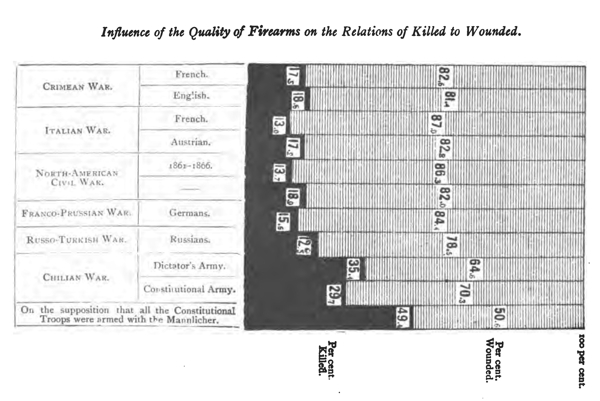
[344]
their small calibre, are more dangerous than the old. Which shows that if all armies had been equipped with the Mannlicher rifle the proportion of killed would have been as high as 49.4 per cent., or practically equal to the number of wounded. This diagram has been formed from the general figures of losses, and to ensure accuracy it would be necessary to deduct the victims of artillery fire and cold steel. But as we have elsewhere explained an immense proportion of casualties are caused by rifle fire, so that the; diagram is, probably, approximately correct.
The losses from wounds constitute but a small part of the total number of sacrifices. In past wars they have been but a fifth, the remaming four-fifths representing losses from sickness and exhaustion. Napoleon in the march to Moscow lost two-thirds of his army though he fought only one general engagement. The Russian armies operating against him, in the course of five months lost four-fifths of their strength. The losses of the Federal armies in the Civil War in two years (June 1861 to June 1863) amounted to 53.2 deaths in the thousand, of which only 8.6 were caused by wounds, and 44.6 by sickness. The mortality from sickness among the officers amounted to 22 in the thousand, while among the men it rose to 46. In the Franco-Prussian war the losses of the Germans were 34.7 per cent, from wounds and only 30 per cent, from sickness. But this is explained by the shortness of the campaign, and by the fact that, being greatly superior in numbers, the Germans were able to send their sick home. On the French side these proportions were reversed.
During the last war with Turkey the Russian armies, numbering in all 592,085 men, lost 16,578 in battle and 44,431 from sickness. In L'Hygiène Militaire, 1886, Morache draws up the following analysis of losses in modern wars:
[345]
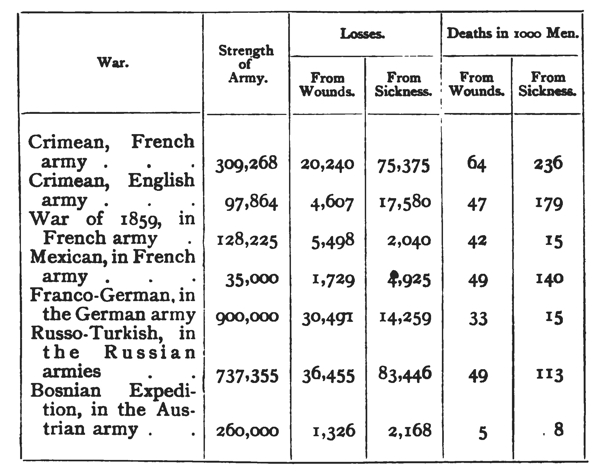
In a future war, for many reasons, we must expect even more deadly results. Bad and insufficient food, in consequence of the difficulty of provisioning immense masses, will mean the increase of sickness; and the overcrowding of the sick at certain points will complicate the danger both from sickness and from wounds, and thereby increase the mortality.
It is further necessary to bear in mind that modem armies will consist of soldiers less accustomed to marching and deprivation, while notwithstanding the lightness of his rifle, the infantryman has to carry a greater weight than before. The German writer Turnwald, who especially studied the question of the weight which the soldier can bear, finds that it ought not to exceed 57 pounds, that is, a third of his own weight. . At the present time the infantryman carries 88 pounds. The weight of the equipment is undoubtedly a factor in causing the exhaustion and susceptibility to sickness observed among the soldiers during [346] manoeuvres. During manoeuvres carried on by the garrison of Strasbourg no less than a third of the soldiers fell out, and the hospitals were filled with sick soldiers. It is true that this was in winter, and many cases were caused by frostbite.
Basing his judgment on the war of 1870-71, in which he took part, General Von der Goltz observes that " in a long and wearisome war aimies undoubtedly deteriorate in quality. Exhaustion and weariness may be borne for several weeks, but not for many months. It is hard to remain a hero, ever ready for self-sacrifice, after daily battles and constarft danger, after long marches through the mud, and nights passed on the wet earth ; all this has a bad effect on courage."
CHAPTER VII. MILITARISM AND ITS NEMESIS
[347]
Those who have considered the facts briefly set out in the foregoing chapters can hardly fail to agree that if European society could form a clear idea, not only of the military character, but also of the social and economic consequences of a future war under present conditions, protests against the present state of things would be expressed more often and more determinedly. But it cannot be affirmed that even this would bring about an amelioration of the present state of affairs. In all countries, with the exception of England, the opinion obtains that great armies are the support of government, that only great armies will deliver the existing order ifrom the perils of anarchism, and that military service acts beneficently on the masses by teaching discipline, obedience and order.
But this theory of the disciplinary influence of military service is overthrown by the fact that, notwithstanding conscription, anarchism constantly spreads among the peoples of the West. It even seems that by teaching the use of arms to the masses, conscription is a far weaker guarantee than the long service of the professional soldier.
But the views of those interested in the present order do not extend so far, and are generally limited by considerations of safety at the present time. This safety the propertied classes see in large armies. As concerns the views of other orders of society, views which are expressed openly and constitute the so-called public opinion, these are too often founded only on those facts [348] to which accident gives prominence. The public does not investigate and does not test independently, but easily gives itself up to illusions and errors. Such, for instance, is the conception of great armies, not only as guarantors of security, but even as existing for the encouragement of those industries which equip them, and those trades which supply them, with provisions and other necessaries.
It must be admitted that to decide the question whether militarism is inevitable or not is no easy task. We constantly hear the argument adduced, that there always have been wars and always will be, and if in the course of all the centuries recorded in history, international disputes were settled only by means of war, how can it be possible to get along without it in the future ? To this we might reply that not only the number, equipment, training, and technical methods of armies, but the very elements from which they are constructed have essentially changed.
The relations of the strength of armies in time of war to their strength in time of peace in former times was very different. Wars formerly were carried on by standing armies consisting mainly of long service soldiers. The armies employed in future wars will be composed mainly of soldiers taken directly from peaceful occupations. Among the older soldiers will be vast numbers of heads of families torn from their homes, their families and their work. The economic life of whole peoples will stand still, communications will be cut, and if war be prolonged over the greater part of a year, general bankruptcy, with famine and all its worst consequences, will ensue. To cast light on the nature of a prolonged war from all sides, military knowledge alone is not enough. The study and knowledge of economic laws and conditions which have no direct connection with military specialism is no less essential.
Consideration of the question is made all the more difficult by the fact that the direction of military affairs belongs to the privileged ranks of society. The opinions expressed by non-specialists as to the improbability of great wars in the future, are refuted by authorities simply [349] by the declaration that laymen are ignorant of the subject. Military men cannot admit to be unnecessary that which forms the object of their activity in time of peace. They have been educated on the history of warfare, and practical work develops in them energy and capacity for self-sacrifice. Nevertheless, such authorities are not in a position to paint a complete picture of the disasters of a future war. Those radical changes which have taken place in the military art, in the composition of armies, and in international economy, are so vast that a powerful imagination would be required adequately to depict the consequences of war, both on the field of battle and in the lives of peoples.
Yet it cannot be denied that popular discontent with the present condition of affairs is becoming more and more keenly noticeable. Formerly only solitary voices were raised against militarism, and their protests were platonic. But since the adoption of conscription the interests of the army have been more closely bound with the interests of society, and the disasters which must be expected under modern conditions have been bettef appreciated by the people.
It is impossible, therefore, not to foresee the constant growth of the anti-military propaganda, the moral foundations of which were not so indisputable in the past as they are to-day. To this moral sentiment has lately been added a consciousness of the complexity of the business relations threatened by war, of the immense increase of means of destruction, and of the deficiency of experienced leadership and the ignorance and cloudiness now prevailing on the subject of war.
All these tend to make the people see in war a misfortune truly terrifying. And if, even in the past, it was found that the sentiments of peoples are more powerful than any force, how much more so now, when in the majority of states the masses indirectly share in the government, and when everywhere exist strong tendencies threatening the whole social order. How much more significant now are the opinions of the people both directly [350] as to the system of militarism and in their influence on the spirit of armies themselves!
It is impossible here even to outline the energetic struggle against militarism which is being carried on in the West. It is true that the advocates of the settlement of international disputes by peaceful means have not attained any tangible success. But success, it must be admitted, they have had if the fact is taken into account that the necessity of maintaining peace has been recognised by governments, and that dread of the terrible disasters of war has been openly expressed by statesmen, and emphasised even from the height of thrones.
As a chief factor tending to preserve the system of militarism the existence of a professional military class must be considered. It is true, that the changes which have taken place under the influence of conscription and short service have given to armies a popular character. On the mobilisation of armies a considerable proportion of officers will be taken from the reserve: these officers cannot be considered professional. Nevertheless, a military professional class continues to exist, consisting mainly of officers serving with the colours.
It is natural that the existence of such a numerous and influential class, which—in Prussia, for instance—is partly hereditary, a class in which are found many men of high culture, should be one of the elements supporting the system of militarism, even independently of its other foundations. Even if the conviction were generally accepted that it is impossible to carry on war with modem methods of destruction and in view of the inevitable disasters, yet disarmament would be somewhat delayed by the existence of the military caste, which would continue to declare that war is inevitable, and that even the decrease of standing armies would be accompanied by the greatest dangers.
It must be admitted that from the nature of modern life, the power and influence of this class will tend to decrease rather than increase. The conditions of war are such that military life is much less attractive than it [351] was of old, and in the course of a few years will be even less attractive. In the far past the military class preponderated in the state and the very nobility, as in Rome, and at the beginning of the Middle Ages was formed of knights (Equites, Ritter, Chevaliers). The carrying on of constant wars in the period embraced by modem history created anew a military profession enjoying a privileged position.
But changes which have taken place in political and social conditions, the increased importance of knowledge, industry, capital, and finally, the immense numbers of the military class, considerably reduced its privileges in society. Rivalry in the acquisition of means for the satisfaction of more complex requirements has caused the majority of educated people to see in military service an ungrateful career. And, indeed, there is no other form of exacting activity which pays so badly as the military profession. Owing to the immense growth of armies, governments cannot find the means for improving the position of officers and their families, and a deficiency in officers is everywhere felt.
Thus, insufficient recompense will inevitably result in the military profession losing all its best forces, all the more so because the fascination for society of persons bearing arms has departed. The movement against militarism leads to views diametrically opposite. Modern ideals every day see less to sympathise with in the old ideals of distinction in battle, and glory of conquest. Everywhere the idea spreads that the efforts of all ought to be devoted to the lessening of the sum of physical and moral suffering. The immense expenditure on the maintenance of armies and fleets and the building, and equipment ot fortresses, acts powerfully in the spreading of such sentiments. Everywhere we hear complaints that militarism sucks the blood of all—as it has been expressed, "in place of ears of corn the fields produce bayonets and sabres, and shells instead of fruit grow on the trees." Those who adopt the military career are, of course, not responsible for these conditions, which they did not create [352] and which react injuriously on themselves. But popular movements do not analyse motives, and discontent with militarism is inevitably transferred to the military class.
It might be replied that scholars, too, are often ill rewarded, notwithstanding which they continue their work. But every scholar is sustained by the high interests of his work, by the hope of perpetuating his name, and finally, by the chance of enriching himself upon success. The position of officers is very different. For an insignificant salary they bear the burden of a petty and monotonous work. Year after year the same labour continues. Hope of distinction in war is not, for none believe in the nearness of war. For an officer with an average education the limit of ambition is the command of a company. The command of a battalion little improves his position. For the command of regiments and larger bodies of troops, academical education is required.
But even among those officers who console themselves with the thought that war will break out, presenting occasion for distinction, there is little hope of attaining the desired promotion. We have had many opportunities for conversing with military men of different nationalities, and everywhere we were met with the conviction that in a future war few would escape. With a smokeless field of battle, accuracy of fire, the necessity for showing example to the rank and file, and the rule of killing off all the officers first, there is but little chance of returning home uninjured.
The times are passed when officers rushing on in advance led their men in a bold charge against the enemy, or when squadrons seeing an ill-defended battery galloped up to it, sabred the gunners, and spiked the guns or flung them into ditches. Courage now is required no less than before, but this is the courage of restraint and self-sacrifice and no longer scenic heroism. War has taken a character more mechanical than knightly. Personal initiative is required not less than before, but it is no longer visible to all.
It is true that warfare and the military profession will [353] continue to preserve their attractions for such restless, uncurbed natures as cannot reconcile themselves to a laborious and regular life, finding a charm in danger itself. But even these will find that the stormy military life and feverish activity of battle are no more surrounded by the aureole which once set them above the world of work.
It is notable that the younger and the better educated they are, the more pessimistically do officers look on war. And although military men do not speak against warfare publicly, for this would be incompatible with their calling, it cannot escape attention that every year fewer and fewer stand up in defence of its necessity or use.
As the popularity of war decreases on all sides, it is impossible not to foresee that a time will approach when European governments can no longer rely on the regular payment of taxes for the covering of military expenditure. The extraordinary resource which has been opened by means of conversion of loans—that is, by the lowering of the rate of interest—will soon disappear. In 1894 a sum of five hundred and twenty millions of pounds sterling was converted, meaning for the proprietors of the securities, a loss of four millions seven hundred and sixty thousand of pounds. To defend themselves against this, capitalists have rushed into industry. In Europe, in recent times, industrial undertakings have immensely increased, and a vast number of joint-stock companies has been formed. The Conservative classes, considered as the best support of authority, foreseeing the loss of income, dispose of their Government securities and invest in industrial securities, which bring a better dividend. State securities tend to fall more and more into the hands of the middle classes— that is, the classes which live on incomes derived from work, but who are nevertheless in a position to save.
These changes tend to make the economic convulsions caused by war far greater than those which have been experienced in the past. The fall in the value of Government securities at the very time when, owing to the stoppage of work, many will be compelled to realise, must cause [354] losses which will be intensely felt by the middle classes and cause a panic. And, as out of the number of industrial undertakings some must reduce their production and lose their profit and others altogether cease to work, the richer classes will suffer great losses and many even ruin.
A detailed examination of the vexed questions of Europe would lead to the conclusion that not one is of such a nature to cause a great war. France has no ally in an offensive war for the recovery of her lost provinces, and single-handed she cannot be assured of success. From an offensive war over the Eastern question neither Russia nor Austria could draw compensatory advantages, and such a war, which in all probability would involve the participation of England, France, Germany and Italy, would lead only to exhaustion of forces. Germany cannot think of attacking France, while out of an offensive war with Russia she could draw no profit.
Of new territory in the West, Russia also has no need, and a war with Germany would involve such immense expenditure as could hardly be covered by an indemnity, all the more so because, exhausted as she would be by a struggle with Russia, Germany could not pay an indemnity corresponding to the case. Generally, the political question for Russia lies in the Far East and not in the West.
As concerns other possible pretexts for war, examination would show that, in the present conditions of Europe, none are of sufficient gravity to cause a war threatening the combatants with mutual annihilation or complete exhaustion, nor need those moral misunderstandings and rivalries which exist between European states be seriously considered. It cannot be supposed that nations would determine to exterminate one another merely to show their superiority, or to avenge offences committed by individuals belonging to one nation against individuals belonging to another. Thus a consideration of all the reasonable causes of war would show that not one was probable.
But even if peace were assured for an indefinite time, the very preparations made, the maintenance of armed [355] forces, and constant rearmaments, would require every year still greater and greater sacrifices. Yet every day new needs arise and old needs are made clearer to the popular mind. These needs remain unsatisfied, though the burden of taxation continually grows. And the recognition of these evils by the people constitutes a serious danger for the state.
In our time both military and political affairs have ceased to be high mysteries accessible only to the few. General military service, the spread of education, and wide publicity have made the elements of the polities of states accessible to all. All who have passed through the ranks of an army have recognised that with modem weapons whole corps and squadrons may be destroyed in the first battle, and that in this respect the conquerors will suffer little less than the conquered.
Can it be possible that the growth of expenditure on armaments will continue for ever ? To the inventiveness of the human mind and the rivalry between states no limits exist. It is not surprising therefore that the immense expenditure on military aims and the consequent growth of taxation are the favourite arguments of agitators, who declare that the institutions of the Middle Ages—when from thousands of castles armed knights pounced upon passing merchants—were less burdensome than modern preparations for war.
The exact disposition of the masses in relation to armaments is shown by the increase in the number of opponents of militarism and preachers of the Socialist propaganda. In Germany in 1893, the opponents of the new military project received 1,097,000 votes more than its supporters. Between 1887 and 1893 the opposition against militarism increased more than seven times. In France the Socialist party in 1893 received 600,000 votes, and in 1896 1,000,000.
Thus, if the present conditions continue, there can be but two alternatives, either ruin from the continuance of the armed peace, or a veritable catastrophe from war.
The question is naturally asked : What will be given to [356] the people after war as compensation for their immense losses ? The conquered certainly will be too exhausted to pay any money indemnity, and compensation must be taken by the retention of frontier territories which will be so impoverished by war that their acquisition will be a loss rather than a gain.
With such conditions can we hope for good sense among millions of men when but a handful of their former officers remain ? Will the armies of Western Europe, where the Socialist propaganda has already spread among the masses, allow themselves to be disarmed, and if not, must we not expect even greater disasters than those which marked the short-lived triumph of the Paris Commune? The longer the present position of affairs continues the greater is the probability of such convulsions after the close of a great war. It cannot be denied that conscription, by taking from productive occupations a greater number of men than the former conditions of service, has increased the popularity of subversive principles among the masses. Formerly only Socialists were known; now Anarchism has arisen. Not long ago the advocates of revolution were a handful; now they have their representatives in all parliaments, and every new election increases their number in Germany, in France, in Austria, and in Italy. It is a strange coincidence that only in England and in the United States, where conscription is unknown, are representative assemblies free from these elements of disintegration. Thus side by side with the growth of military burdens rise waves of popular discontent threatening a social revolution.
Such are the consequences of the so-called armed peace of Europe—slow destruction in consequence of expenditure on preparations for war, or swift destruction in the event of war—in both events convulsions in the social order.